#Supreme Council of Antiquities
Text


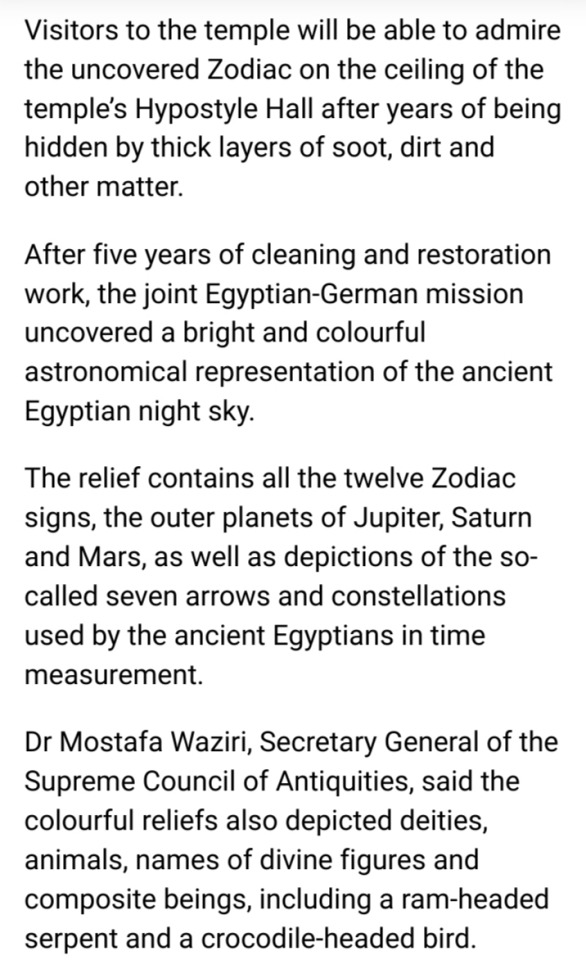

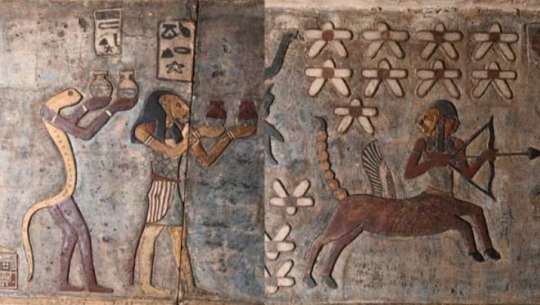

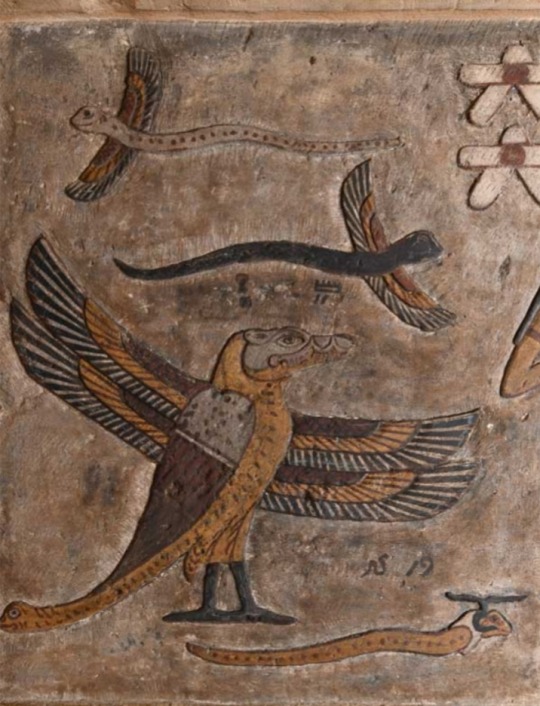
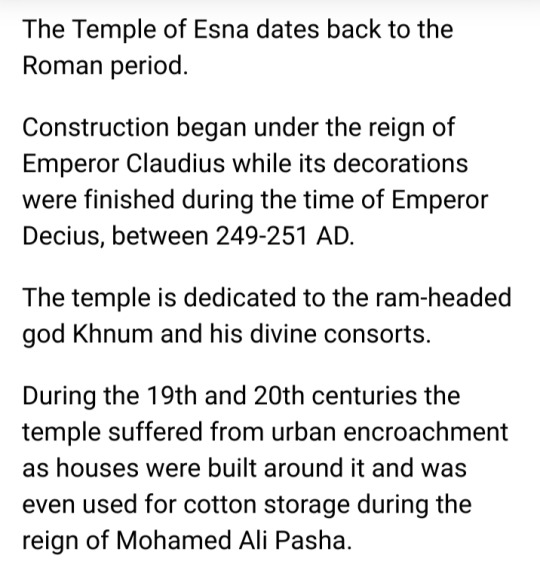

#Temple of Esna#Luxor#Zodiac#Ministry of Tourism and Antiquities#Hypostyle Hall#zodiac signs#Supreme Council of Antiquities#Babylonian astronomy#American Research Centre#Emperor Claudius#Emperor Decius#Khnum#archaeology
123 notes
·
View notes
Text
Archaeologists Excavating the Tomb of Egypt’s First Female Pharaoh Found Hundreds of Jars Still Holding Remnants of Wine
The dig has also shed new light on the reign of the ancient queen.
— Adam Schrader | October 18, 2023
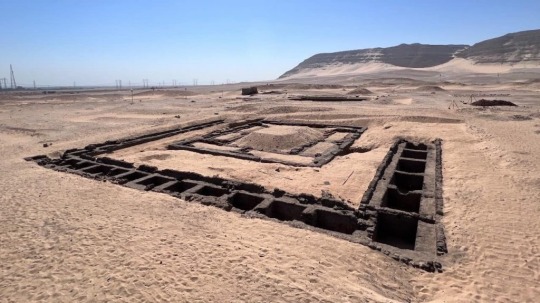
An archaeology team has discovered evidence that the Ancient Egyptian Queen Merneith “had a great position” and was responsible for the central government offices. Photo courtesy of Egypt’s Ministry of Tourism and Archaeology
Archaeologists digging in one of the oldest cities in Egypt have discovered evidence that sheds new light on the life of the ancient Egyptian queen Merneith, who ruled during the 1st Dynasty.
The excavation of a tomb in the Umm al-Qaab area in Abydos found an inscription on a “Stone Vessel” that provides new historical information about Merneith’s reign, during which she held “A Great Position” and was responsible for the central government offices, said Christiana Köhler, who led the dig.
“It has been speculated that Merneith may have been the first female Pharaoh in Ancient Egypt,” Köhler said in a news release, “but her true identity remains a mystery,”

A fragment of a stone vessel recently found in the tomb of Queen Merneith. It has an incised inscription with her name on the right and the mention of the royal treasury on the left. Photo courtesy of EC Köhler, M Minotti.
Köhler specified that Merneith, also known as Meret-Neith, may have been in charge of the treasury among other government offices, supporting the idea of her historical significance. She is the only 1st-Dynasty woman whose tomb has been uncovered in Abydos so far.
“Considering that these are the remains of people’s lives and actions from 5,000 years ago, we are stunned every day at the amazing detail we encounter during our investigations, including the perfectly preserved grape seeds, craftwork and even footprints in the mud,” Köhler said over email.
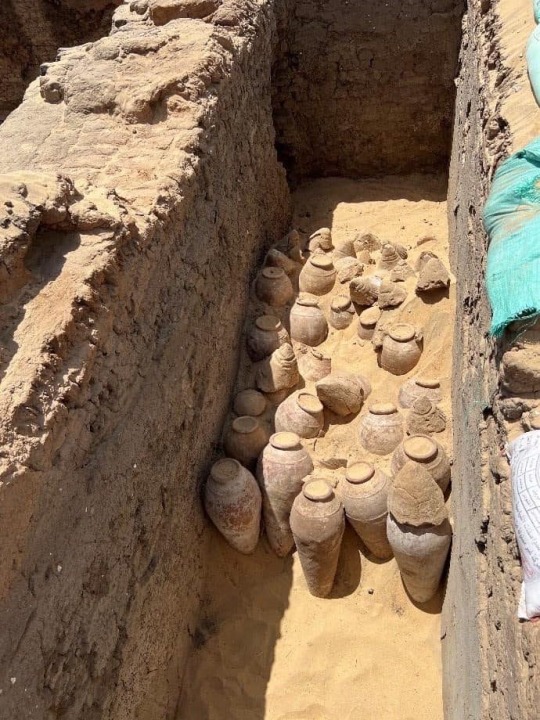
The Wine Jars are seen during the excavation of Merneith’s Tomb. Photo courtesy of Egypt’s Ministry of Tourism and Archaeology
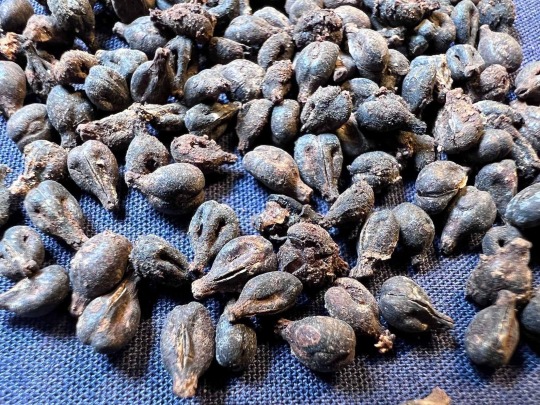
Perfectly Preserved Grape 🍇 Seeds: Egypt’s Tourism Ministry highlighted hundreds of 5,000-year-old wine jars found in the tomb in the Umm al-Qaab area in Abydos, one of the oldest cities in Egypt located about 354 miles south of Cairo. Photo courtesy of Egypt’s Ministry of Tourism and Archaeology
Discoveries made in the dig also “challenge the long-held belief in human sacrifice,” Köhler added in the news release.
Next to Merneith’s burial site, archaeologists found a group of 41 tombs for her courtiers and servants, indicating these chambers were built during different periods of time.
“This observation, together with other evidence, radically challenges the oft-proposed, but unproven idea of ritual human sacrifice in the 1st Dynasty,” Köhler said.
The news release highlighted the discovery of hundreds of 5,000-year-old wine jars that had never been opened. The archaeological team—hailing from Egypt, Germany and Austria—found the remains of wine inside.
Mustafa Waziri, Secretary General of Egypt’s Supreme Council of Antiquities, said in a statement that the discovered jars are large in size and “in a good condition of preservation.”
“Some of them are very well preserved with their jar stoppers still intact,” Köhler said.
#Archaeology#Ancient Egyptian QueenMerneith#Egypt 🇪🇬#Egypt’s First Female Pharaoh#Archaeologists | Jars 🫙 | Wine 🍷#Tomb | Umm al-Qaab area | Abydos#1st Dynasty#Egypt’s Ministry of Tourism & Archaeology#Stone Vessel#Christiana Köhler#Preserved Grape 🍇 Seeds | Craftwork | Footprints 👣#Mustafa Waziri | Secretary General | Egypt’s Supreme Council of Antiquities
0 notes
Text
What a fascinating find! New things are always being discovered!
#egypt#egyptian archaeology#egyptology#Egyptian-British archaeological mission#Supreme Council of Antiquities (SCA)#New Kingdom Research Foundation#royal tomb#Western Valley#Theban Mountain#Luxor#Thutmosid period#18th Dynasty#ancient tombs#ancient egypt#history#ancient history#egyptian archaeologists#archaeological finds#archæology#archaeology#archaeological excavation
0 notes
Text
INTACT SIXTEEN METRE LONG BOOK OF THE DEAD
*VIBRATING*
2K notes
·
View notes
Text
Looted ancient sarcophagus returned to Egypt from US

An ancient wooden sarcophagus that was featured at the Houston Museum of Natural Sciences was returned to Egypt after U.S. authorities determined it was looted years ago, Egyptian officials said Monday.
The repatriation is part of Egyptian government efforts to stop the trafficking of its stolen antiquities. In 2021, authorities in Cairo succeeded in getting 5,300 stolen artifacts returned to Egypt from across the world.
Mostafa Waziri, the top official at the Supreme Council of Antiquities, said the sarcophagus dates back to the Late Dynastic Period of ancient Egypt, an era that spanned the last of the Pharaonic rulers from 664 B.C. until Alexander the Great's campaign in 332 B.C. Read more.
1K notes
·
View notes
Text
Archeaology gives us the name of another woman in History
Archaeologists digging in one of the oldest cities in Egypt have discovered evidence that sheds new light on the life of the ancient Egyptian queen Merneith, who ruled during the 1st Dynasty.
The excavation of a tomb in the Umm al-Qaab area in Abydos found an inscription on a “stone vessel” that provides new historical information about Merneith’s reign, during which she held “a great position” and was responsible for the central government offices, said Christiana Köhler, who led the dig.
“It has been speculated that Merneith may have been the first female Pharaoh in Ancient Egypt,” Köhler said in a news release, “but her true identity remains a mystery,”
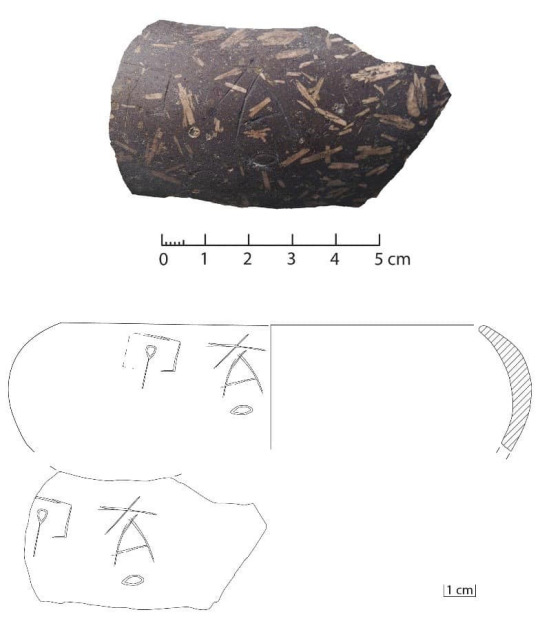
A fragment of a stone vessel recently found in the tomb of Queen Merneith. It has an incised inscription with her name on the right and the mention of the royal treasury on the left. Photo courtesy of EC Köhler, M Minotti.
Köhler specified that Merneith, also known as Meret-Neith, may have been in charge of the treasury among other government offices, supporting the idea of her historical significance. She is the only 1st-Dynasty woman whose tomb has been uncovered in Abydos so far.
“Considering that these are the remains of people’s lives and actions from 5,000 years ago, we are stunned every day at the amazing detail we encounter during our investigations, including the perfectly preserved grape seeds, craftwork and even footprints in the mud,” Köhler said over email.
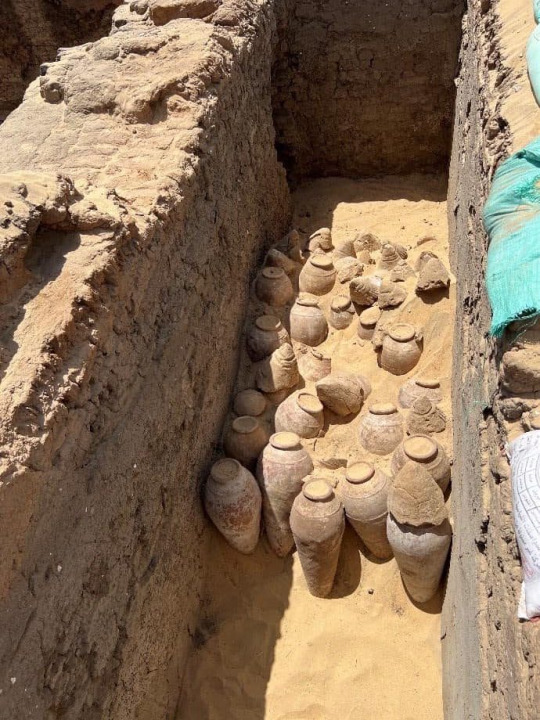
The wine jars are seen during the excavation of Merneith’s tomb. Photo courtesy of Egypt’s Ministry of Tourism and Archaeology

Egypt’s Tourism Ministry highlighted hundreds of 5,000-year-old wine jars found in the tomb in the Umm al-Qaab area in Abydos, one of the oldest cities in Egypt located about 354 miles south of Cairo. Photo courtesy of Egypt’s Ministry of Tourism and Archaeology
Discoveries made in the dig also “challenge the long-held belief in human sacrifice,” Köhler added in the news release.
Next to Merneith’s burial site, archaeologists found a group of 41 tombs for her courtiers and servants, indicating these chambers were built during different periods of time.
“This observation, together with other evidence, radically challenges the oft-proposed, but unproven idea of ritual human sacrifice in the 1st Dynasty,” Köhler said.
The news release highlighted the discovery of hundreds of 5,000-year-old wine jars that had never been opened. The archaeological team—hailing from Egypt, Germany and Austria—found the remains of wine inside.
Mustafa Waziri, Secretary General of Egypt’s Supreme Council of Antiquities, said in a statement that the discovered jars are large in size and “in a good condition of preservation.”
“Some of them are very well preserved with their jar stoppers still intact,” Köhler said.
#women in history#Discoveries in Archaeology#Egypt#Ancient Egypt#queen Merneith#1st Dynasty#Abydos#Queen Meret-Neith#5000 years ago#Umm al-Qaab
279 notes
·
View notes
Text

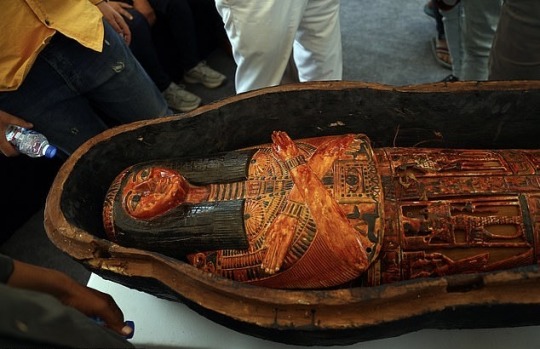

3,400-Year-Old Ancient Egyptian Cemetery Found With Colorful Coffins
Archaeologists have uncovered an Ancient Egyptian cemetery dated to more than 3,000 years ago containing the colorful coffin of a high priest's daughter and preserved mummies, among hundreds of other finds.
Researchers unearthed the cemetery at the Tuna el-Gebel necropolis, located almost 170 miles south of Cairo in Minya Governate, Egypt's Ministry of Tourism and Antiquities announced in a statement on Sunday.
The cemetery, which dates back to the New Kingdom (16th-11th centuries B.C.) of ancient Egypt, was used as a burial ground for senior officials and priests during the period, according to archaeologists.
The cemetery was uncovered during excavations that began last August in the Al-Ghuraifa area of Tuna El-Gebel and features "many tombs" that have been carved into rock.
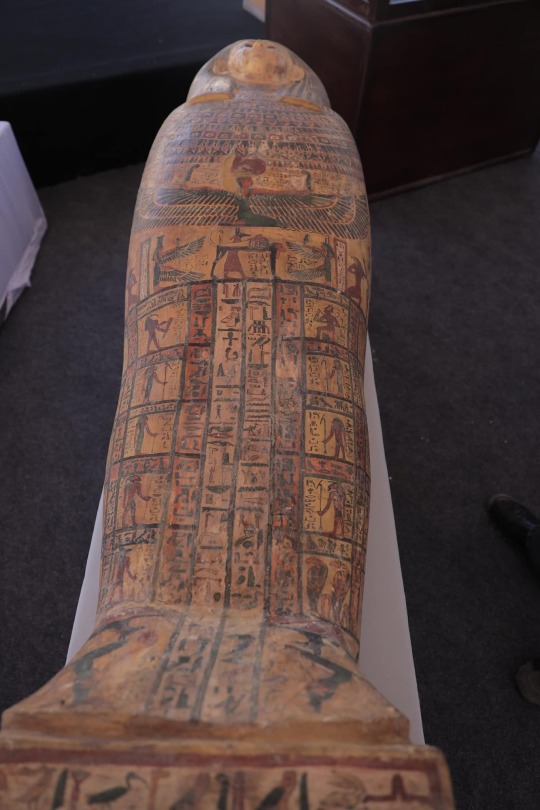
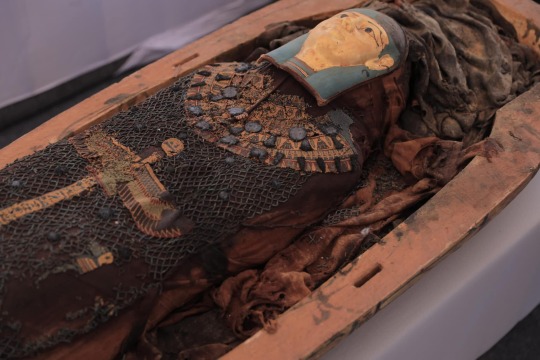
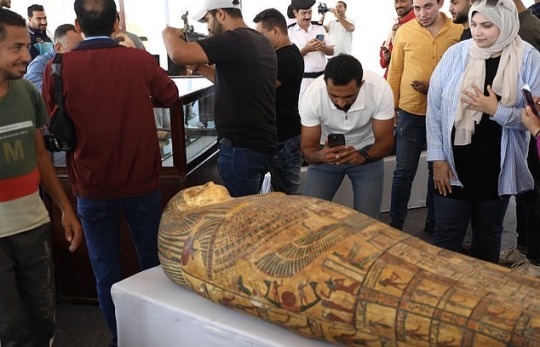
Researchers have also made hundreds of archaeological finds at the site, including stone and wooden coffins—some of which contained mummies—amulets, ornaments and funerary figurines.
One of the most notable finds at the cemetery is a colorful, engraved coffin belonging to the daughter of a high priest of the ancient Egyptian god Djehuti, often referred to as Thoth.
This deity, commonly depicted as a man with the head of an ibis or baboon, was a key figure in ancient Egyptian mythology and played several prominent roles. For example, Thoth was credited with the invention of writing and is also believed to have served as a representative of the sun god Ra.
Next to the coffin of the high priest's daughter, archaeologists found two wooden boxes containing her canopic jars, as well as a complete set of "ushabti" statues.


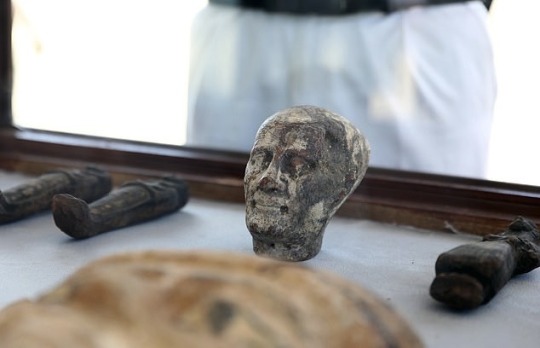
Canopic jars were vessels used by the ancient Egyptians to store the organs removed from the body in the process of mummification—the lungs, liver, intestines and stomach—in order to preserve them for the afterlife.
Ushabti statues, meanwhile, were figurines used in ancient Egyptian funerary practices that were placed in tombs in the belief that they would act as servants for the deceased in the afterlife.
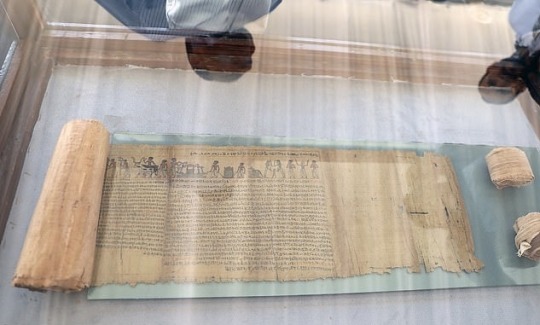

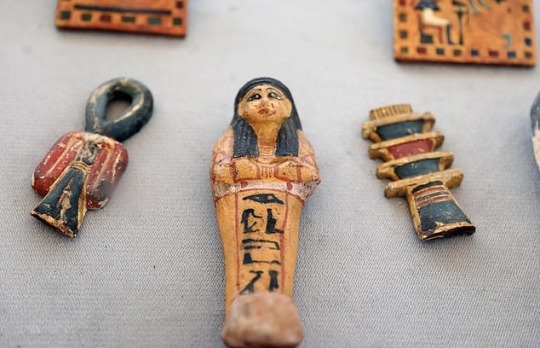

Archaeologists also made another particularly fascinating find at the New Kingdom cemetery: a complete and well-preserved papyrus scroll measuring approximately 42-49 feet in length that features information related to the Book of the Dead.
The Book of the Dead is a collection of ancient Egyptian funerary texts consisting of spells or magic formulas that were placed in tombs. These texts were thought to protect and aid the deceased in the afterlife. They were generally written on papyrus, a material similar to thick paper that was used as a writing surface in ancient times.
Mostafa Waziri, secretary general of the Supreme Council of Antiquities, said in the statement that the discovery of the cemetery is an "important" find.
By Aristos Georgiou.

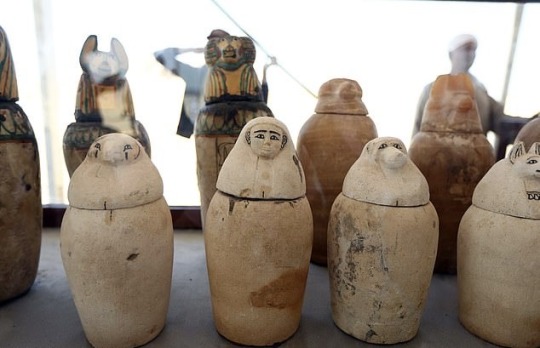
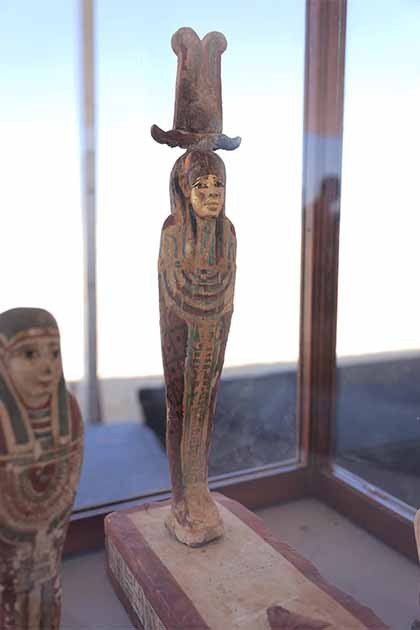

#3400-Year-Old Ancient Egyptian Cemetery Found With Colorful Coffins#Tuna el-Gebel necropolis#Minya Governate#ancient grave#ancient tomb#ancient cemetery#ancient necropolis#book of the dead#canopic jars#Egyptian god Djehuti#high priest#high priestess#ancient artifacts#archeology#archeolgst#history#history news#ancient history#ancient culture#ancient civilizations#ancient egypt#egyptian history#egyptian gods#egyptian mythology#egyptian art
182 notes
·
View notes
Text
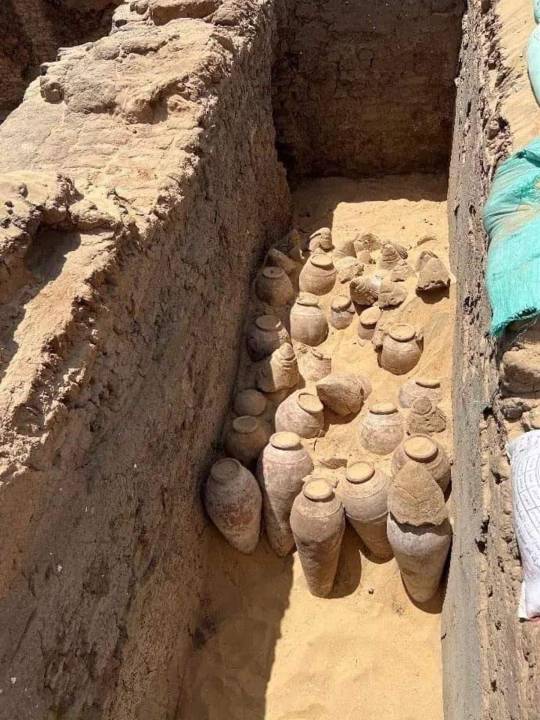
5000-Year-Old Pharaonic wine jars found intact at Abydos
The Egyptian-German-Austrian archaeological mission excavating the tomb of Queen Merit-Neith of the 1st Dynasty in Umm El Qa’ab at Abydos in Sohag, succeeded in uncovering hundreds of sealed jars, containing remnants of wine, in addition to uncovering a group of funerary equipment.
Mostafa Waziri, Secretary General of the Supreme Council of Antiquities, said the archaeological team found several grave goods, including hundreds of large wine jars, some of which had intact stoppers and contained the well-preserved remains of 5000-year-old wine.
Inscriptions also indicate that Merit-Neith had been in charge of central government offices, like the treasury, which lends credence to the theory that she played a historically significant role, Waziri noted.
Read more
112 notes
·
View notes
Photo
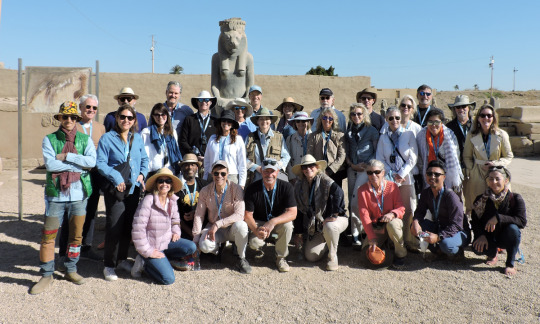
We began work on January 28, but the highlight of this week was the January 31 visit to the site by Anne Pasternak, the Brooklyn Museum Director, and members of the Museum’s Board of Governors. We were thrilled to be able to show them the site where Brooklyn has worked for the past 40+ years. We hope they enjoyed their visit.

As promised last week, here are the members of our team. Our foreman again this year is Abdel Aziz Farouk Sharid (left). He and our inspector, Haitham Mohamed Sa’ad el-Din are discussing the season’s work. The Supreme Council of Antiquities (SCA) assigns an inspector to every expedition to act as liaison with the SCA and help facilitate the work. We are happy to have Haitham with us this season.

Besides Abdel Aziz, the Qufti who working with us this year are Abdel Aziz’s brother Ayman Farouk Sharid (center), the foreman for the Johns Hopkins University expedition who works with us when Hopkins isn’t in the field; and Mamdouh Kamil, who has worked with us for many seasons. All are from the village of Quft (ancient Coptos), which has a long tradition of archaeology going back to the late 19th century. Ayman and Abdel Aziz are the sons of one of the great Egyptian archaeologists, the late Farouk Sharid Mohamed, who was a beloved friend and treasured colleague. His sons are worthy successors to him.

You are looking northwest at the first court of Temple A, which stands northeast of the Mut Temple. We are working in two areas of the court this year. In 2019 we were able to confirm that that the row of limestone features on the court’s south side were sphinx bases. This season we want to see if there are remains of corresponding bases on the north side (right). We are also clearing the corridor between the south colonnade and the south wall of the court (left).

By the end of the week (February 2) the results in the north square were equivocal. Looking north, you can see an area of decayed limestone on the right side of the square that might be the remains of a sphinx base. On February 1, Mamdouh uncovered the round, dark feature to the left of the “sphinx base” that might be a tree hole. Sphinx avenues often had trees planted between the sculptures.

The work on the corridor was more productive. By the middle of the week Ayman had cleared a mass of broken stone and revealed the lowest course of the court’s south wall (left) and the footing of the temple’s 2nd Pylon. Both sit on a sand foundation that you can see below the blocks of stone. It was common to use sand in the foundations to level out uneven ground.

On February 1 our Dutch colleague, Jacobus (Jaap) van Dijk joined us for another season. First thing on the morning of February 2, Ayman called us over to show us an interesting find: a large relief-decorated block. Jaap immediately got down to have a look.

The block has a beautifully carved relief of Amun that clearly is Thutmoside in style, that is, from the reign of Hatshepsut and/or Thutmosis III, of the mid-15th century BC. What makes it particularly interesting is the small, shallowly carved graffito of a God’s Wife of Amun facing the Amun and dating stylistically to Dynasty 25 or 26, about 700 years after the god’s face was carved. God’s Wives of Amun were priestesses, usually the sisters or daughters of kings, who wielded great political power in the Third Intermediate Period and later.
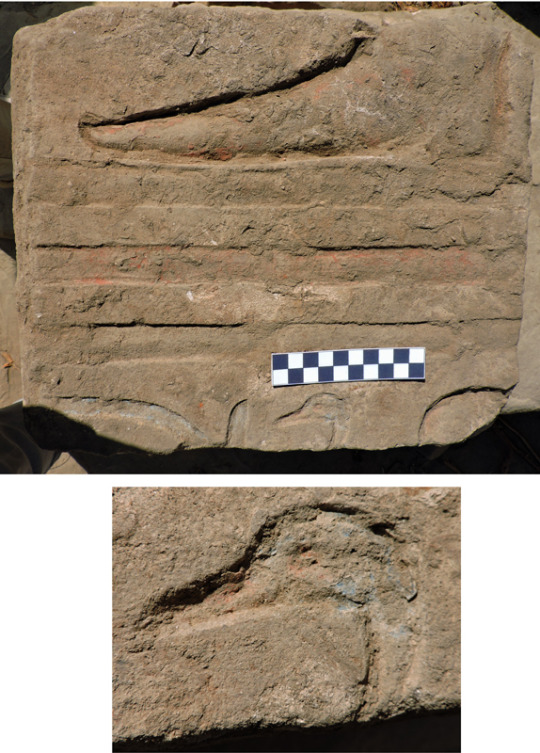
Just west of the Amun block was smaller cube of stone with a sunk relief depiction of a man’s foot on base lines with the top of a cartouche and the “son of Re” title below. The style of the foot (very long) and the vertical element of the cartouche date it to the reign of Akhenaten. It probably came originally from his temple in East Karnak, built before the king moved the capital to Amarna. The artist paid attention to detail when painting the relief, painting the head of the goose (“son”) blue but its beak and eye red. The Brooklyn Museum has an interesting group of Amarna Period reliefs showing a pastoral scene.

By the end of the week Ayman and his crew had cleared the bases of the first 3 columns of the colonnade, working from west to east. The blocks of the bases are large: 70 cm by 125 cm and almost 100 cm thick.
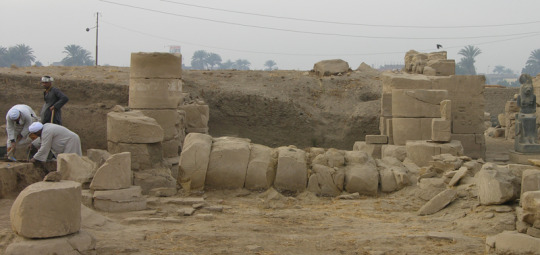
We are also planning on restoring 2 fallen columns in the colonnaded porches in front of the Mut Temple. The one in the East Porch is shown here as it was found in 1979. Work hasn’t started on these yet; there will be more about the restoration next week.
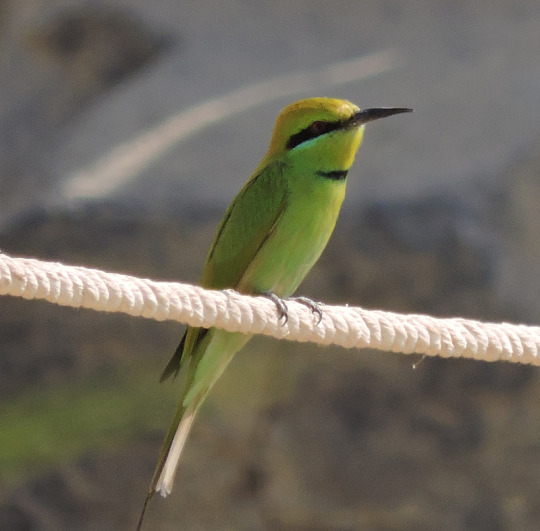
One of our favorite birds is the tiny, bright bee eater, so called because it catches insects in mid-air. This is the first we’ve seen this season.

An unusual cloud formation seen at sunset one night. Angels? Extraterrestrials?
Posted by Richard Fazzini and Mary McKercher
#BkMMutDig#MutDig#Mut#temple#Egypt#excavation#BkMEgyptianArt#egyptian art#egyptian#amarna period#Akhenaten#Thutmoside#archaeology#Brooklyn Museum#brooklyn#museum#art
223 notes
·
View notes
Text
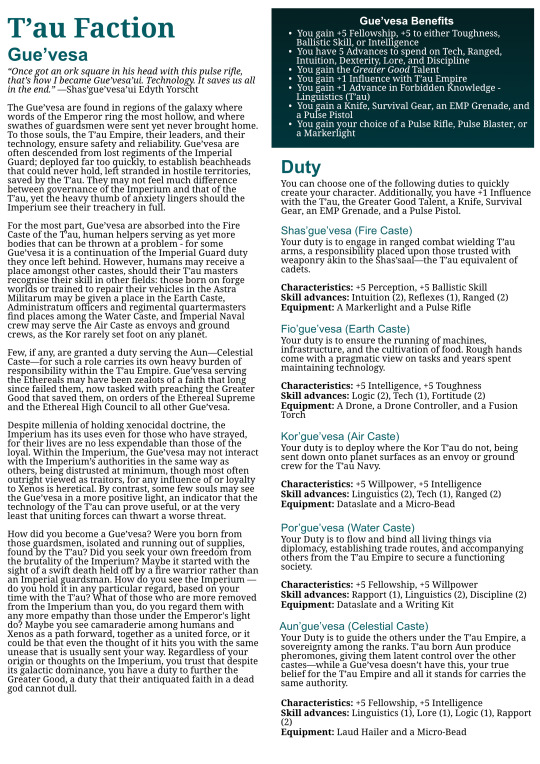
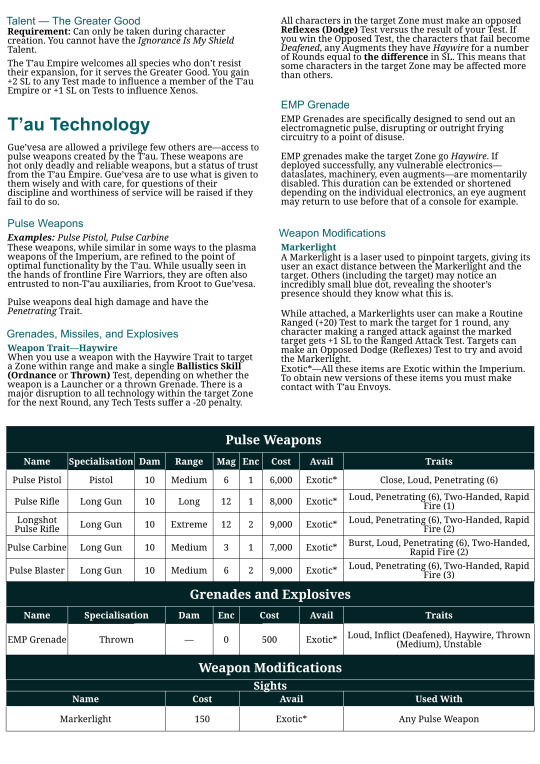
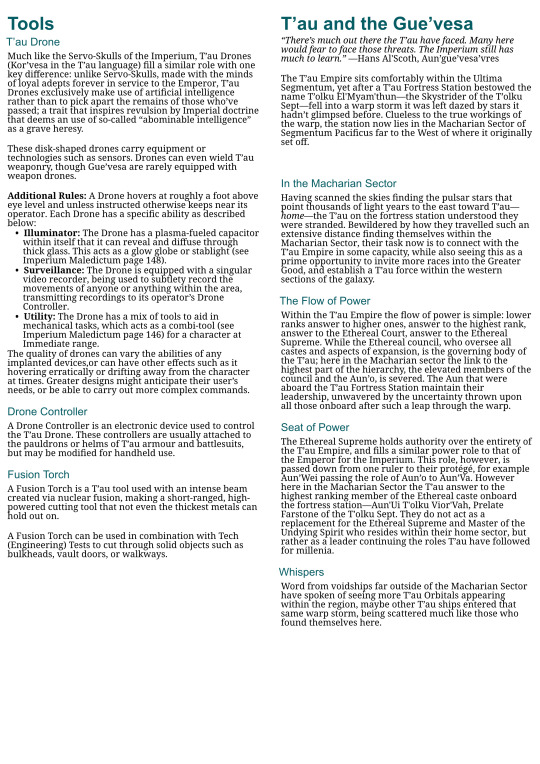

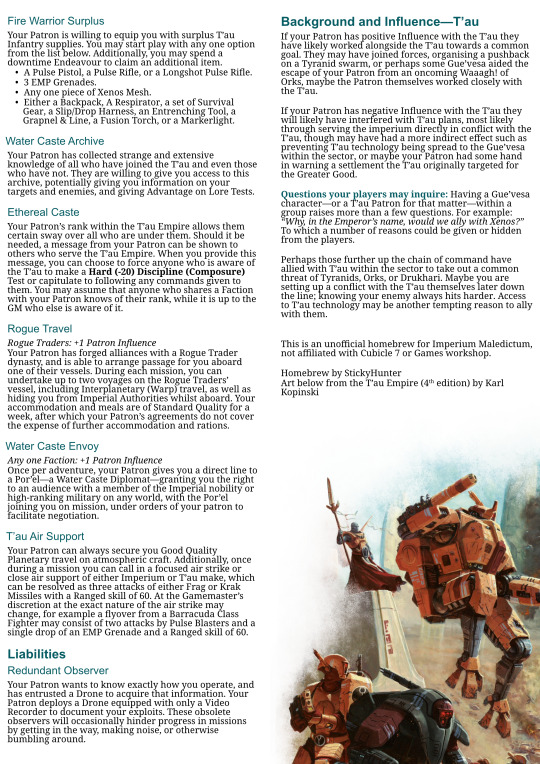
Gue'vesa and the T'au Empire—rules for Imperium Maledictum
Want to play a human under the T'au or have a T'au Patron for that matter? Well hey I've got you covered!
Plain text version under the cut
T’au Faction
Gue’vesa
“Once got an ork square in his head with this pulse rifle, that’s how I became Gue’vesa’ui. Technology. It saves us all in the end.” —Shas’gue’vesa’ui Edyth Yorscht
The Gue’vesa are found in regions of the galaxy where words of the Emperor ring the most hollow, and where swathes of guardsmen were sent yet never brought home. To those souls, the T’au Empire, their leaders, and their technology, ensure safety and reliability. Gue’vesa are often descended from lost regiments of the Imperial Guard; deployed far too quickly, to establish beachheads that could never hold, left stranded in hostile territories, saved by the T’au. They may not feel much difference between governance of the Imperium and that of the T’au, yet the heavy thumb of anxiety lingers should the Imperium see their treachery in full.
For the most part, Gue’vesa are absorbed into the Fire Caste of the T’au, human helpers serving as yet more bodies that can be thrown at a problem - for some Gue’vesa it is a continuation of the Imperial Guard duty they once left behind. However, humans may receive a place amongst other castes, should their T’au masters recognise their skill in other fields: those born on forge worlds or trained to repair their vehicles in the Astra Militarum may be given a place in the Earth Caste, Administratum officers and regimental quartermasters find places among the Water Caste, and Imperial Naval crew may serve the Air Caste as envoys and ground crews, as the Kor rarely set foot on any planet.
Few, if any, are granted a duty serving the Aun—Celestial Caste—for such a role carries its own heavy burden of responsibility within the T’au Empire. Gue’vesa serving the Ethereals may have been zealots of a faith that long since failed them, now tasked with preaching the Greater Good that saved them, on orders of the Ethereal Supreme and the Ethereal High Council to all other Gue’vesa.
Despite millenia of holding xenocidal doctrine, the Imperium has its uses even for those who have strayed, for their lives are no less expendable than those of the loyal. Within the Imperium, the Gue’vesa may not interact with the Imperium’s authorities in the same way as others, being distrusted at minimum, though most often outright viewed as traitors, for any influence of or loyalty to Xenos is heretical. By contrast, some few souls may see the Gue’vesa in a more positive light, an indicator that the technology of the T’au can prove useful, or at the very least that uniting forces can thwart a worse threat.
How did you become a Gue’vesa? Were you born from those guardsmen, isolated and running out of supplies, found by the T’au? Did you seek your own freedom from the brutality of the Imperium? Maybe it started with the sight of a swift death held off by a fire warrior rather than an Imperial guardsman. How do you see the Imperium — do you hold it in any particular regard, based on your time with the T’au? What of those who are more removed from the Imperium than you, do you regard them with any more empathy than those under the Emperor's light do? Maybe you see camaraderie among humans and Xenos as a path forward, together as a united force, or it could be that even the thought of it hits you with the same unease that is usually sent your way. Regardless of your origin or thoughts on the Imperium, you trust that despite its galactic dominance, you have a duty to further the Greater Good, a duty that their antiquated faith in a dead god cannot dull.
Gue’vesa Benefits
You gain +5 Fellowship, +5 to either Toughness, Ballistic Skill, or Intelligence
You have 5 Advances to spend on Tech, Ranged, Intuition, Dexterity, Lore, and Discipline.
You gain the Greater Good Talent.
You gain +1 Influence with T’au Empire
You gain +1 Advance in Forbidden Knowledge - Linguistics (T’au)
You gain a Knife, Survival Gear, an EMP Grenade, and a Pulse Pistol
You gain your choice of a Pulse Rifle, Pulse Blaster, or a Markerlight
Duty
You can choose one of the following duties to quickly create your character. Additionally, you have +1 Influence with the T’au, the Greater Good Talent, a Knife, Survival Gear, an EMP Grenade, and a Pulse Pistol.
Shas’gue’vesa (Fire Caste)
Your duty is to engage in ranged combat wielding T’au arms, a responsibility placed upon those trusted with weaponry akin to the Shas’saal—the T’au equivalent of cadets.
Characteristics: +5 Perception, +5 Ballistic Skill
Skill advances: Intuition (2), Reflexes (1), Ranged (2)
Equipment: A Markerlight and a Pulse Rifle
Fio’gue’vesa (Earth Caste)
Your duty is to ensure the running of machines, infrastructure, and the cultivation of food. Rough hands come with a pragmatic view on tasks and years spent maintaining technology.
Characteristics: +5 Intelligence, +5 Toughness
Skill advances: Logic (2), Tech (1), Fortitude (2)
Equipment: A Drone, a Drone Controller, and a Fusion Torch
Kor’gue’vesa (Air Caste)
Your duty is to deploy where the Kor T’au do not, being sent down onto planet surfaces as an envoy or ground crew for the T’au Navy.
Characteristics: +5 Willpower, +5 Intelligence
Skill advances: Linguistics (2), Tech (1), Ranged (2)
Equipment: Dataslate and a Micro-Bead
Por’gue’vesa (Water Caste)
Your Duty is to flow and bind all living things via diplomacy, establishing trade routes, and accompanying others from the T’au Empire to secure a functioning society.
Characteristics: +5 Fellowship, +5 Willpower
Skill advances: Rapport (1), Linguistics (2), Discipline (2)
Equipment: Dataslate and a Writing Kit
Aun’gue’vesa (Celestial Caste)
Your Duty is to guide the others under the T’au Empire, a sovereignty among the ranks. T’au born Aun produce pheromones, giving them latent control over the other castes—while a Gue’vesa doesn’t have this, your true belief for the T’au Empire and all it stands for carries the same authority.
Characteristics: +5 Fellowship, +5 Intelligence
Skill advances: Linguistics (1), Lore (1), Logic (1), Rapport (2)
Equipment: Laud Hailer and a Micro-Bead
Talent — The Greater Good
Requirement: Can only be taken during character creation. You cannot have the Ignorance Is My Shield Talent.
The T’au Empire welcomes all species who don’t resist their expansion, for it serves the Greater Good. You gain +2 SL to any Test made to influence a member of the T’au Empire or +1 SL on Tests to influence Xenos.
T’au Technology
Gue’vesa are allowed a privilege few others are—access to pulse weapons created by the T’au. These weapons are not only deadly and reliable weapons, but a status of trust from the T’au Empire. Gue’vesa are to use what is given to them wisely and with care, for questions of their discipline and worthiness of service will be raised if they fail to do so.
Pulse Weapons
Examples: Pulse Pistol, Pulse Carbine
These weapons, while similar in some ways to the plasma weapons of the Imperium, are refined to the point of optimal functionality by the T’au. While usually seen in the hands of frontline Fire Warriors, they are often also entrusted to non-T’au auxiliaries, from Kroot to Gue’vesa.
Pulse weapons deal high damage and have the Penetrating Trait.

Grenades, Missiles, and Explosives
Weapon Trait—Haywire
When you use a weapon with the Haywire Trait to target a Zone within range and make a single Ballistics Skill (Ordnance or Thrown) Test, depending on whether the weapon is a Launcher or a thrown Grenade. There is a major disruption to all technology within the target Zone for the next Round, any Tech Tests suffer a -20 penalty.
All characters in the target Zone must make an opposed Reflexes (Dodge) Test versus the result of your Test. If you win the Opposed Test, the characters that fail become Deafened, any Augments they have Haywire for a number of Rounds equal to the difference in SL. This means that some characters in the target Zone may be affected more than others.
EMP Grenade
EMP Grenades are specifically designed to send out an electromagnetic pulse, disrupting or outright frying circuitry to a point of disuse.
EMP grenades make the target Zone go Haywire. If deployed successfully, any vulnerable electronics—dataslates, machinery, even augments—are momentarily disabled. This duration can be extended or shortened depending on the individual electronics, an eye augment may return to use before that of a console for example.

Weapon Modifications
Markerlight
A Markerlight is a laser used to pinpoint targets, giving its user an exact distance between the Markerlight and the target. Others (including the target) may notice an incredibly small blue dot, revealing the shooter’s presence should they know what this is.
While attached, a Markerlights user can make a Routine Ranged (+20) Test to mark the target for 1 round, any character making a ranged attack against the marked target gets +1 SL to the Ranged Attack Test. Targets can make an Opposed Dodge (Reflexes) Test to try and avoid the Markerlight.

Exotic*—All these items are Exotic within the Imperium. To obtain new versions of these items you must make contact with T’au Envoys.
Tools
T’au Drone
Much like the Servo-Skulls of the Imperium, T’au Drones (Kor’vesa in the T’au language) fill a similar role with one key difference: unlike Servo-Skulls, made with the minds of loyal adepts forever in service to the Emperor, T’au Drones exclusively make use of artificial intelligence rather than to pick apart the remains of those who’ve passed; a trait that inspires revulsion by Imperial doctrine that deems an use of so-called “abominable intelligence” as a grave heresy.
These disk-shaped drones carry equipment or technologies such as sensors. Drones can even wield T’au weaponry, though Gue’vesa are rarely equipped with weapon drones.
Additional Rules: A Drone hovers at roughly a foot above eye level and unless instructed otherwise keeps near its operator. Each Drone has a specific ability as described below:
Illuminator: The Drone has a plasma-fueled capacitor within itself that it can reveal and diffuse through thick glass. This acts as a glow globe or stablight (see Imperium Maledictum page 148).
Surveillance: The Drone is equipped with a singular video recorder, being used to subtlety record the movements of anyone or anything within the area, transmitting recordings to its operator’s Drone Controller.
Utility: The Drone has a mix of tools to aid in mechanical tasks, which acts as a combi-tool (see Imperium Maledictum page 146) for a character at Immediate range.
The quality of drones can vary the abilities of any implanted devices,or can have other effects such as it hovering erratically or drifting away from the character at times. Greater designs might anticipate their user’s needs, or be able to carry out more complex commands.
Drone Controller
A Drone Controller is an electronic device used to control the T’au Drone. These controllers are usually attached to the pauldrons or helms of T’au armour and battlesuits, but may be modified for handheld use.
Fusion Torch
A Fusion Torch is a T’au tool used with an intense beam created via nuclear fusion, making a short-ranged, high-powered cutting tool that not even the thickest metals can hold out on.
A Fusion Torch can be used in combination with Tech (Engineering) Tests to cut through solid objects such as bulkheads, vault doors, or walkways.
T’au and the Gue’vesa
“There’s much out there the T’au have faced. Many here would fear to face those threats. The Imperium still has much to learn.” —Hans Al'Scoth, Aun’gue’vesa’vres
The T’au Empire sits comfortably within the Ultima Segmentum, yet after a T’au Fortress Station bestowed the name T’olku El'Myam'thun—the Skystrider of the T’olku Sept—fell into a warp storm it was left dazed by stars it hadn’t glimpsed before. Clueless to the true workings of the warp, the station now lies in the Macharian Sector of Segmentum Pacificus far to the West of where it originally set off.
In the Macharian Sector
Having scanned the skies finding the pulsar stars that point thousands of light years to the east toward T’au—home—the T’au on the fortress station understood they were stranded. Bewildered by how they travelled such an extensive distance finding themselves within the Macharian Sector, their task now is to connect with the T’au Empire in some capacity, while also seeing this as a prime opportunity to invite more races into the Greater Good, and establish a T’au force within the western sections of the galaxy.
The Flow of Power
Within the T’au Empire the flow of power is simple: lower ranks answer to higher ones, answer to the highest rank, answer to the Ethereal Court, answer to the Ethereal Supreme. While the Ethereal council, who oversee all castes and aspects of expansion, is the governing body of the T’au; here in the Macharian sector the link to the highest part of the hierarchy, the elevated members of the council and the Aun’o, is severed. The Aun that were aboard the T’au Fortress Station maintain their leadership, unwavered by the uncertainty thrown upon all those onboard after such a leap through the warp.
Seat of Power
The Ethereal Supreme holds authority over the entirety of the T’au Empire, and fills a similar power role to that of the Emperor for the Imperium. This role, however, is passed down from one ruler to their protégé, for example Aun’Wei passing the role of Aun’o to Aun’Va. However here in the Macharian Sector the T’au answer to the highest ranking member of the Ethereal caste onboard the fortress station—Aun'Ui T'olku Vior'Vah, Prelate Farstone of the T'olku Sept. They do not act as a replacement for the Ethereal Supreme and Master of the Undying Spirit who resides within their home sector, but rather as a leader continuing the roles T’au have followed for millenia.
Whispers
Word from voidships far outside of the Macharian Sector have spoken of seeing more T’au Orbitals appearing within the region, maybe other T’au ships entered that same warp storm, being scattered much like those who found themselves here.
Patrons
As a Gue’vesa, your Patron is likely a servant of the T’au Empire, or, in a rare show of fragile trust between the T’au Empire and Imperium, you serve an Imperial Patron.
T’au Patron
Your Patron is a member of the T’au Empire, seizing their chance in this new territory to establish a beachhead and secure alliances. Unknown to the everyday citizen of the Imperium, the T’au would appear to be just another Xenos threat, yet your Patron hopes with a helpful hand that Imperial systems will slowly come to see the higher truth of the Greater Good. The looming presence of the Imperium is ever in your Patron’s mind, forcing them into political engagements that are beyond complex.
Influence: Your Patron has +2 Influence with the T’au Empire.
Duty: Your Patron is either a Shas’o—A Fire Commander—or a Aun’saal—an Ethereal Lord.
Shas’o (Fire Commander)
Your Patron holds the highest rank within the T’au army, similar to that of a Commander. While many within the fire caste see this as the only way of leaving the T’au military aside from death, others seize it as an opportunity for control. Your Patron not only understands warfare, but has seen it up-close at a scale like few in the Fire Caste let alone the T'au Empire have been unfortunate enough to witness.
Free Boon: T’au Firepower
Your Patron is able to procure T’au weaponry with little interruption. You have Advantage on Availability Tests for T’au technology, T’au technology becomes 2 steps easier to obtain.
Aun’saal (Ethereal Lord)
Your Patron is a high-ranking T’au, a lord in their own right, and not one to mince words. Their word is law, and those words can prove inspirational. Your Patron is studious, knowing words can cut like a sword; and that negotiation is just as powerful as any gun.
Free Boon: Ethereal Caste
Your Patron’s rank within the T’au Empire allows them certain sway over all who are under them. Should it be needed, a message from your Patron can be shown to others who serve the T’au Empire. When you provide this message, you can choose to force anyone who is aware of the T’au to make a Hard (-20) Discipline (Composure) Test or capitulate to following any commands given to them. You may assume that anyone who shares a Faction with your Patron knows of their rank, while it is up to the GM who else is aware of it.


Anything marked with an * is listed below, all others listed are found within the Imperium Maledictum Core Book.
Boons
Auxilarist
Your Patron can call on a small squad of Kroot Mercenaries that can be found within the Macharian Sector. Once per mission, your Patron can put a number of Kroot Mercenaries (page 349) equal to the number of characters in the party under the party’s command for a day. The Kroot Mercenaries are under the control of the Gamemaster, and have been instructed to aid the party.
T’au Firepower
Your Patron is able to procure T’au weaponry with little interruption. You have Advantage on Availability Tests, T’au technology becomes 2 steps easier to obtain.
Fire Warrior Surplus
Your Patron is willing to equip you with surplus T’au Infantry supplies. You may start play with any one option from the list below. Additionally, you may spend a downtime Endeavour to claim an additional item.
A Pulse Pistol, a Pulse Rifle, or a Longshot Pulse Rifle.
3 EMP Grenades.
Any one piece of Xenos Mesh.
Either a Backpack, A Respirator, a set of Survival Gear, a Slip/Drop Harness, an Entrenching Tool, a Grapnel & Line, a Fusion Torch, or a Markerlight.
Water Caste Archive
Your Patron has collected strange and extensive knowledge of all who have joined the T’au and even those who have not. They are willing to give you access to this archive, potentially giving you information on your targets and enemies, and giving Advantage on Lore Tests.
Ethereal Caste
Your Patron’s rank within the T’au Empire allows them certain sway over all who are under them. Should it be needed, a message from your Patron can be shown to others who serve the T’au Empire. When you provide this message, you can choose to force anyone who is aware of the T’au to make a Hard (-20) Discipline (Composure) Test or capitulate to following any commands given to them. You may assume that anyone who shares a Faction with your Patron knows of their rank, while it is up to the GM who else is aware of it.
Rogue Travel
Rogue Traders: +1 Patron Influence
Your Patron has forged alliances with a Rogue Trader dynasty, and is able to arrange passage for you aboard one of their vessels. During each mission, you can undertake up to two voyages on the Rogue Traders’ vessel, including Interplanetary (Warp) travel, as well as hiding you from Imperial Authorities whilst aboard. Your accommodation and meals are of Standard Quality for a week, after which your Patron’s agreements do not cover the expense of further accommodation and rations.
Water Caste Envoy
Any one Faction: +1 Patron Influence
Once per adventure, your Patron gives you a direct line to a Por’el—a Water Caste Diplomat—granting you the right to an audience with a member of the Imperial nobility or high-ranking military on any world, with the Por’el joining you on mission, under orders of your patron to facilitate negotiation.
T’au Air Support
Your Patron can always secure you Good Quality Planetary travel on atmospheric craft. Additionally, once during a mission you can call in a focused air strike or close air support of either Imperium or T’au make, which can be resolved as three attacks of either Frag or Krak Missiles with a Ranged skill of 60. At the Gamemaster’s discretion at the exact nature of the air strike may change, for example a flyover from a Barracuda Class Fighter may consist of two attacks by Pulse Blasters and a single drop of an EMP Grenade and a Ranged skill of 60.
Liabilities
Redundant Observer
Your Patron wants to know exactly how you operate, and has entrusted a Drone to acquire that information. Your Patron deploys a Drone equipped with only a Video Recorder to document your exploits. These obsolete observers will occasionally hinder progress in missions by getting in the way, making noise, or otherwise bumbling around.
Background and Influence—T’au
If your Patron has positive Influence with the T’au they have likely worked alongside the T’au towards a common goal. They may have joined forces, organising a pushback on a Tyranid swarm, or perhaps some Gue’vesa aided the escape of your Patron from an oncoming Waaagh! of Orks, maybe the Patron themselves worked closely with the T’au.
If your Patron has negative Influence with the T’au they will likely have interfered with T’au plans, most likely through serving the imperium directly in conflict with the T’au, though may have had a more indirect effect such as preventing T’au technology being spread to the Gue’vesa within the sector, or maybe your Patron had some hand in warning a settlement the T’au originally targeted for the Greater Good.
Questions your players may inquire: Having a Gue’vesa character—or a T’au Patron for that matter—within a group raises more than a few questions. For example: “Why, in the Emperor’s name, would we ally with Xenos?” To which a number of reasons could be given or hidden from the players. Perhaps those further up the chain of command have allied with T’au within the sector to take out a common threat of Tyranids, Orks, or Drukhari. Maybe you are setting up a conflict with the T’au themselves later down the line; knowing your enemy always hits harder. Access to T’au technology may be another tempting reason to ally with them.
#imperium maledictum#warhammer 40k#warhammer 40000#warhammer 40k roleplay#t'au#t'au empire#gue'vesa#guevesa#homebrew#hey i made a thing! I really wanted to practice writing something that wasn't 5e so chose a *chef kiss* system
55 notes
·
View notes
Text
@enignoema from here
This was an unusual place to find the Secretary General of the Supreme Council of Antiquities, especially while alone. But it was also unusual for her to have the ability to see through time, or a doctorate at the age of 20, so it was par for the course that Ishizu Ishtar was a woman who did many unusual things.
She sat in Gotham's most nameless bar, a glass of beer with a few sips already gone still forming beads of condensation on the outside.
Despite her diminutive stature, like the rest of her family, she was both blessed and burdened by a strong presence. This was only bolstered by her manner of dress, sleeveless white fabric with a golden neckline only made brighter by the fact she was practically dripping with jewelry, ranging from golden cuffs and anklets to rings bearing turquoise scarabs and inlaid signets. A headdress topped with a familiar golden eye and sharp wings. Far flashier than what she wore for her official appearances. The embodiment of a tomb's hidden treasures.
And of course, the Necklace, which always gave off the impression that it was watching you, despite its inanimacy.
She had found him there, because she knew he would be there-- asking questions about things he very much shouldn't. So she had acted first.
"I am not a woman of violence, Mr. Riddler." Although she certainly could be. "And there are far worse things in this world than being killed."
Hauntingly familiar turn of phrase, wasn't it?
"I'm sure we can come to a suitable agreement, should you be willing to keep your weapons where they belong. I am also more than persistent enough to continue putting walls in your path, but it brings me no joy, and I have other matters to attend to."
14 notes
·
View notes
Text
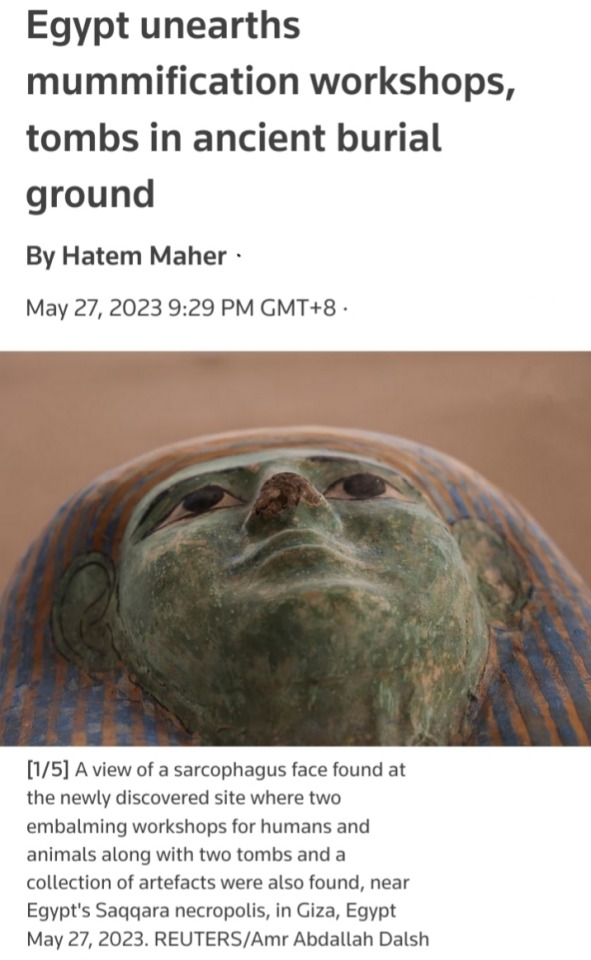
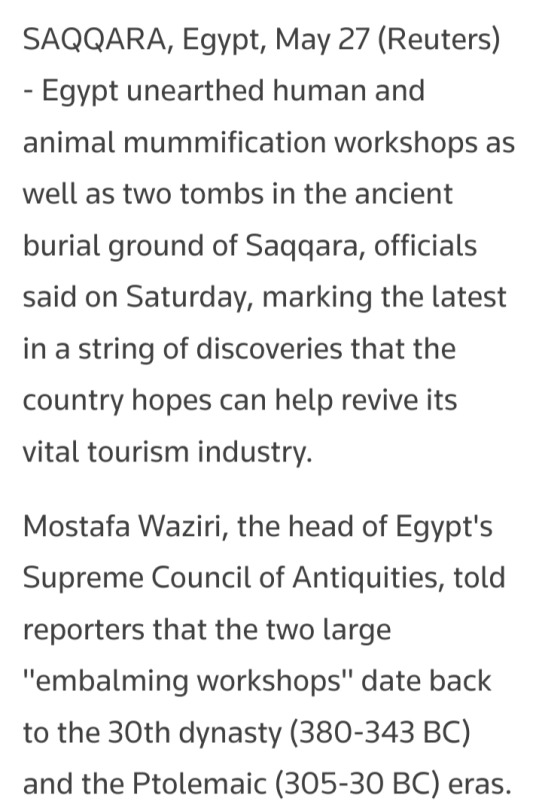
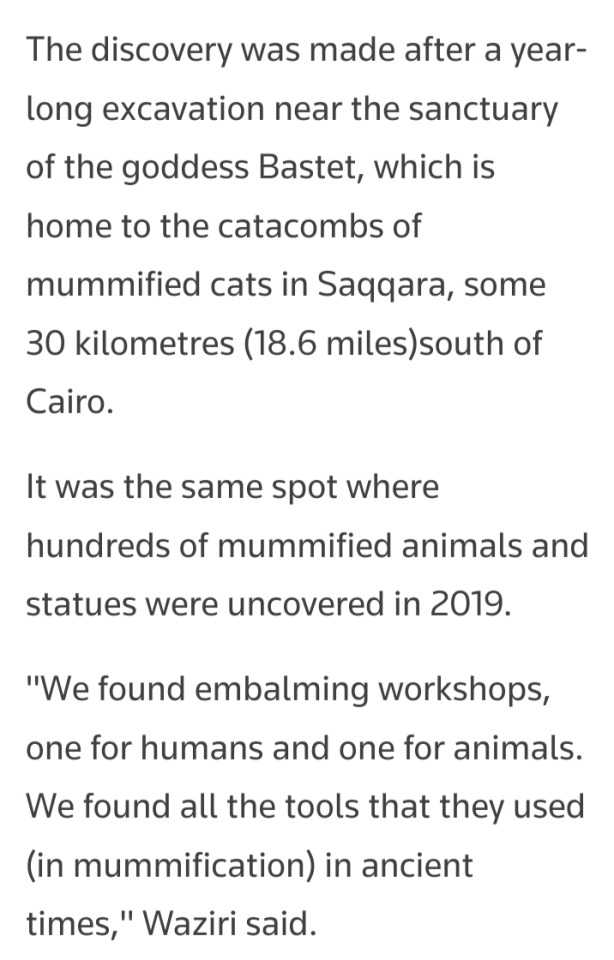
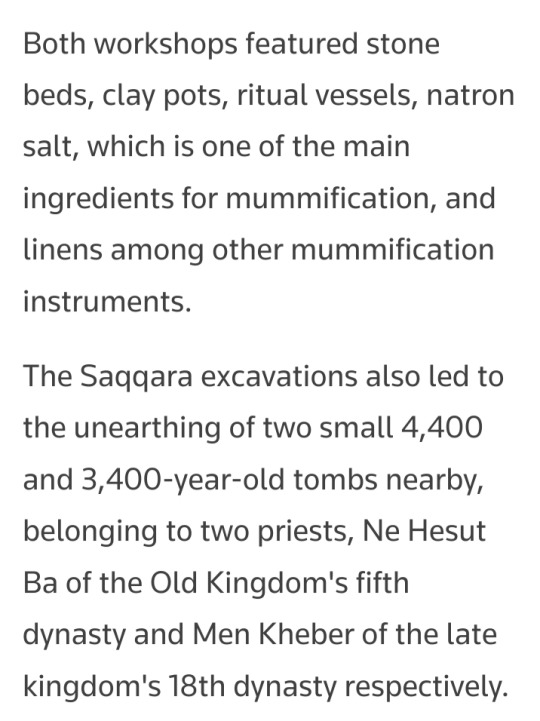


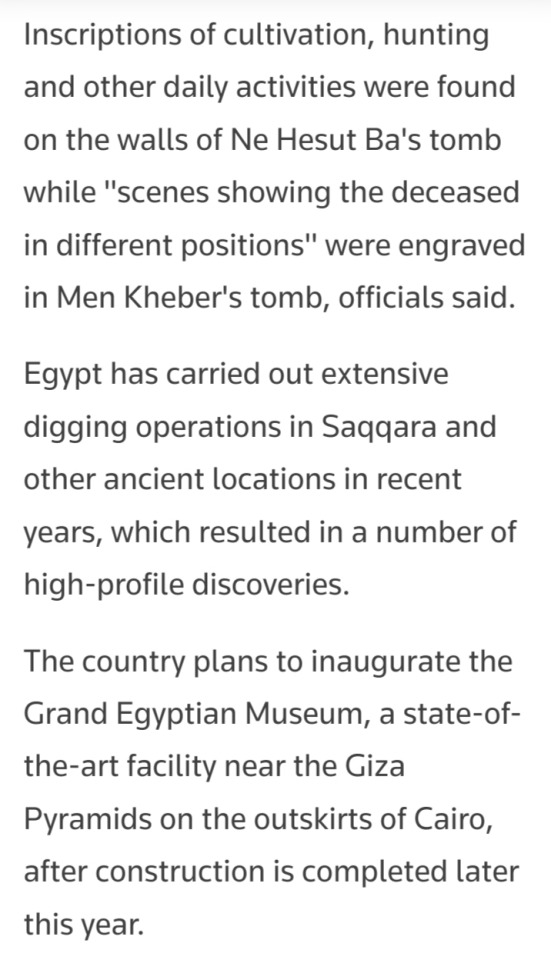
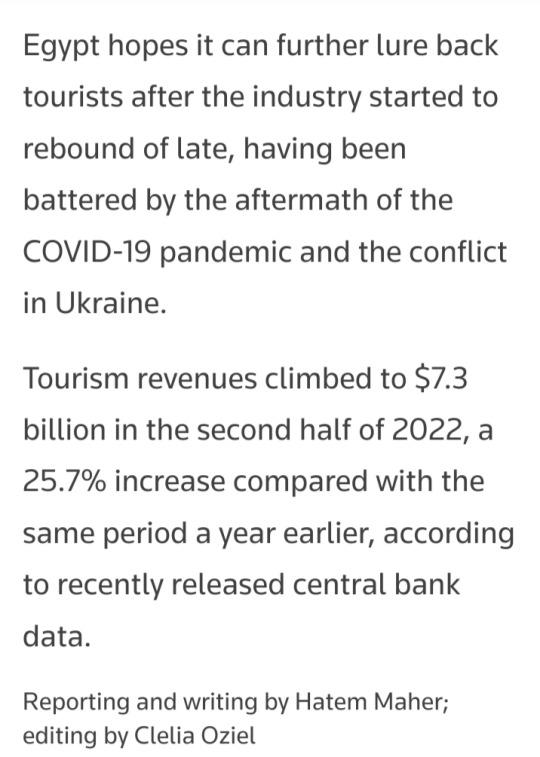
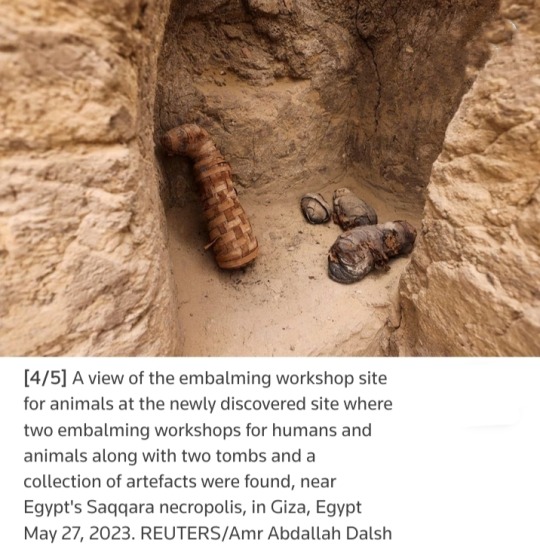

#Egypt#Saqqara#mummies#mummification#Supreme Council of Antiquities#Bastet#embalming workshops#excavation#Grand Egyptian Museum#Giza Pyramids#ancient tomb#Ancient Egypt
3 notes
·
View notes
Text
Egyptian authorities have spoken out about the casting of a black actress as Cleopatra in an upcoming Netflix documentary series.
34 notes
·
View notes
Text

Egypt bans Dutch archaeology team from Saqqara due to museum’s ‘Afrocentric’ exhibition
A team of archaeologists from a Dutch museum has been banned from carrying out excavations in Egypt’s rich Saqqara necropolis, after the museum mounted an exhibition that drew condemnation from Egyptian authorities.
After the opening of “Kemet: Egypt in Hip Hop, Jazz, Soul & Funk,” the National Museum of Antiquities (RMO) in Leiden received an email from the head of foreign missions of the Egyptian Antiquities Service saying that the museum is “falsifying history” with its “Afrocentric” approach, Dutch newspaper NRC reported on Monday.
Wim Weijland, the museum’s managing director, confirmed to CNN via email that the Egyptian authorities have denied the institution a permit for the next excavation season at Saqqara. He also confirmed that the journalist who wrote the NRC article had seen the email from the Egyptian authorities.
A vast burial ground that sits nearly 20 miles south of the capital Cairo, Saqqara is home to Egypt’s oldest pyramid, the pyramid of Djoser, and has been the site of multiple important discoveries in recent years.
The museum has been carrying out annual excavations there for more than 40 years. Its most recent excavation campaign took place earlier this year, between February 19 and March 23.
“The Rijksmuseum van Oudheden has been working at Saqqara since 1975,” Weijland told CNN. “For the upcoming season, the museum has been denied the permit to excavate here.”
Weijland said the reason for the permit’s denial is the “presumed ‘falsifying history’ in the current exhibition,” adding that the museum is trying to “open the dialogue” with the Egyptian authorities about the matter.
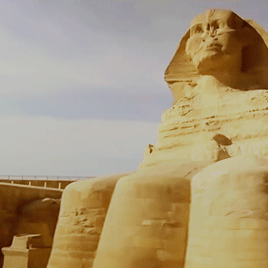
Mostafa Waziri, secretary-general of the Supreme Council of Antiquities of Egypt, did not respond to CNN’s request for comment.
Weijland went on to say that the aim of the “Kemet” exhibition is “to show and understand the depiction of ancient Egypt and the messages in music by African artists,” as well as to “show what scientific, Egyptological research can tell us about ancient Egypt and Nubia.”
Nubia is an ancient region in northeast Africa that extends from the Nile River valley in Egypt, all the way down to Khartoum in modern-day Sudan. The area was once home to the Nubian Kingdom of Kush, or the “African Pharaohs.”
According to its web page, the exhibition, which opened in April and runs until September 3, “embarks on a journey through music history” and looks at “the influence of ancient Egypt and Nubia…in the works of a multitude of musicians of African descent, including icons of jazz such as Miles Davis and Sun Ra and contemporary artists such as Beyoncé and Rihanna.”
In recent days, the museum’s social media posts about the exhibition were flooded with comments, mostly by Egyptians who deemed it disrespectful. Some commented with photos showing light-skinned ancient Egyptian drawings, next to ones with darker skin tones, which they say the museum is propagating.
In response to the controversy, the museum added a note on its website with further information about the show’s content, background and goals. It also said it would remove offensive or racist comments from its social media platforms.
The museum encouraged visitors to “visit the exhibition and form their own opinions,” saying it “welcomes respectful dialogue on the cultural heritage of Egypt and Nubia.”
This isn’t the first time Egypt has objected to the depiction of its ancient ancestors. It recently criticized the Netflix docuseries “Queen Cleopatra,” which portrays the ruler of the Ptolemaic Kingdom of Egypt as a woman of color.
Zahi Hawass, an Egyptologist and former Egyptian minister of antiquities, wrote last month that “no one with even a little education could make a film showing Cleopatra as African
#african#afrakan#kemetic dreams#africans#afrakans#brownskin#brown skin#african culture#afrakan spirituality#north ifriqiya#ifriqiya#cnn#cnn news#nubia#ta meri#ta seti#east africa
24 notes
·
View notes
Note
OC is a villain? I am desperate to know more about that one XD
Ask and ye shall receive! I got a bit lazy and just copy/pasted from my docs lol
*****
Takes place 2 years after the Ceremonial Duel. Starts off with Ryou attending a benefit event hosted by the Egyptian Supreme Council of Antiquities to commemorate the restoration of Pharaoh Atem’s name to history. He is there for only two reasons: His father, and Marik. He and Marik have secretly become a ‘casual thing’, with Ryou understanding that he’s a 'surrogate' for the one Marik really wants. Yugi is there as well with his grandfather.
Both Yugi and Ryou are introduced to the newest member of the Antiquities Council, Doctor Kanika Sat’anpu (OC under a different name). She has heard the stories from the Ishtar’s of what happened during the events leading up to the Ceremonial Duel. She thinks that it is important to know the true name of the Thief King that made the dark pact with Zorc Necrophades, and believes that it is unfair that TK has been forgotten, while Zorc is remembered. She even has Marik on her side, pointing out the similarities between TK and Marik where both made extreme choices because of horrible acts against them.
Marik is acting strange, following Kanika like a puppy on a leash. Ishizu points it out, and expresses her concern about her new colleague with Yugi and Ryou.
Meanwhile, Marik is struggling. He’s being paraded around like a puppet…and he’s aware of it. Kanika has him under a mind control spell, similar to what he had once done with the Millennium Rod. She wants to bring back TK, and while Marik wants this more than anything, he doesn’t want it in the way she does.
In ancient times, TK had encountered Kanika. She had hidden him from the Pharaoh’s guards, and he had explained what the Royal family had done to his people, converting her to his cause. She became a loyal ally, devoting herself to him, and was devastated when the Pharaoh sealed him away. Something TK never knew about her was that she was the demigod Daughter of Anubis.
Kanika needs someone with a strong connection in this era to TK to bring him back. She uses her Marik puppet to convince Ryou to aid her and Marik’s ‘cause’, offering to bring back Dark Marik in exchange (why idk?). Ryou agrees, becoming another puppet. Kanika isn’t finished. She wants vengeance for what Atem did. She uses her new puppets to try to convince Yugi to ‘help’ bring back Atem. Yugi wants nothing more than to see Atem again, but believes that coming back isn’t something Atem would want.
Kanika becomes furious. She WILL have her vengeance. She wants TK back. She’s secretly harbored her feelings towards him throughout the millennia, and has vowed to stop at nothing to bring him back.
Not sure about the details after this.
Sat’anpu roughly translates to ‘Daughter of Anubis’
Fun fact: Instead of Sanura, I used to have Kat's demigod form referred to as Kanika, which was short for Kanika Mau (aka 'Black Cat'...because that is how creative I am with names lol). I decided to use that as Kat's 'villain' name as a reference to that.
So basically this AU is a direct opposite of longfic lol
Help me procrastinate
3 notes
·
View notes
Text
52-foot-long Book of the Dead papyrus from ancient Egypt discovered at Saqqara

Archaeologists in Egypt have discovered a 52-foot-long (16 meters) papyrus containing sections from the Book of the Dead. The more than 2,000-year-old document was found within a coffin in a tomb south of the Step Pyramid of Djoser at Saqqara.
There are many texts from The Book of the Dead, and analysis of the new finding may shed light on ancient Egyptian funerary traditions. Conservation work is already complete, and the papyrus is being translated into Arabic, according to a translated statement, which was released in conjunction with an event marking Egyptian Archaeologists Day on Jan. 14.
This is the first full papyrus to be uncovered at Saqqara in more than 100 years, Mostafa Waziry, secretary general of the Supreme Council of Antiquities, said, according to the statement. Read more.
621 notes
·
View notes